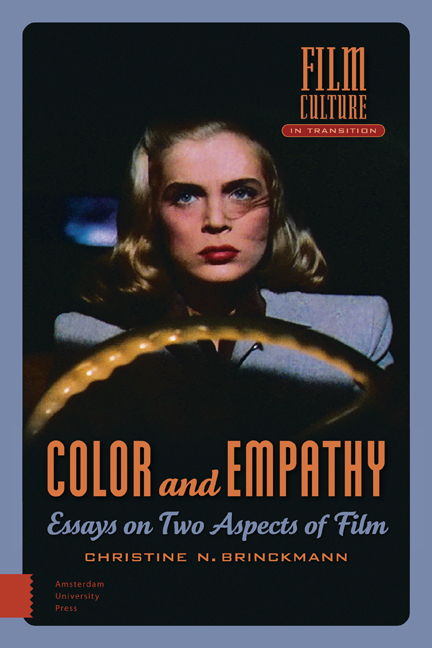Book contents
- Frontmatter
- Contents
- Preface
- Dedication
- Cinematic Color as Likeness and as Artifact: [2001]
- Chords of Color: [2006]
- The Tension of Colors in Colorized Silent Films: [2001]
- Structural Film, Structuring Color: Jenny Okun's Still Life: [1995]
- Desert Fury: A Film Noir in Color: [2012]
- The Work of the Camera: BEAU TRAVAIL: [2005]
- Empathy with the Animal: [1997]
- Motor Mimicry in Hitchcock: [1999]
- Abstraction and Empathy in the Early German Avant-garde: [1997]
- The Role of Empathy in Documentary Film: A Case Study: [2005]
- Genre Conflict in Tracey Emin’s Top Spot: [2007]
- Viewer Empathy and Mosaic Structure in Frederick Wiseman’s PRIMATE: [2009]
- CASTA DIVA: An Empathetic Reading: [2008]
- Publication Data
- Index of Films
- Index of Subjects
- Film Culture in Transition
Motor Mimicry in Hitchcock: [1999]
Published online by Cambridge University Press: 23 June 2021
- Frontmatter
- Contents
- Preface
- Dedication
- Cinematic Color as Likeness and as Artifact: [2001]
- Chords of Color: [2006]
- The Tension of Colors in Colorized Silent Films: [2001]
- Structural Film, Structuring Color: Jenny Okun's Still Life: [1995]
- Desert Fury: A Film Noir in Color: [2012]
- The Work of the Camera: BEAU TRAVAIL: [2005]
- Empathy with the Animal: [1997]
- Motor Mimicry in Hitchcock: [1999]
- Abstraction and Empathy in the Early German Avant-garde: [1997]
- The Role of Empathy in Documentary Film: A Case Study: [2005]
- Genre Conflict in Tracey Emin’s Top Spot: [2007]
- Viewer Empathy and Mosaic Structure in Frederick Wiseman’s PRIMATE: [2009]
- CASTA DIVA: An Empathetic Reading: [2008]
- Publication Data
- Index of Films
- Index of Subjects
- Film Culture in Transition
Summary
Various new publications in the field of cognitive theory of the audience have encouraged me to contribute my own findings regarding a certain phenomenon in the work of Alfred Hitchcock: the prominent placement of moments that trigger motor mimicry in the viewer. Using myself as a kind of guinea pig, I observed my personal reactions while watching one Hitchcock film after another, until a pattern emerged.
My project had a dual focus. It was intended, on the one hand, as a contribution to Hitchcock scholarship, in particular to Hitchcock stylistics; on the other, as a study of motor mimicry in the cinema – the physical response of the audience to specific visual stimuli. Both issues share the observation that nearly all of Hitchcock's films, from his early silent period to his late work, include passages in which the viewers are so powerfully involved in observing the physical acts onscreen that their own muscles begin to join in.
Motor mimicry belongs in the spectrum of empathy and is one of a number of related processes: for example, “affective mimicry,” which is an involuntary (but reduced and fleeting) sharing of basic feelings that can be read from another's facial expressions and body language; or “emotional simulation,” which is an attempt to imagine oneself in another's situation as a way of exploring his or her state of mind or need to act. In each case, there is feedback about the other person's concerns that can produce insights or anticipations. Empathetic processes should not be equated with processes of identification, however, since they represent only a temporary, partial equalizing with the person observed. Even if that person's emotional and physical experiences become the observer's own feelings for a moment, preoccupying his or her body, the person observed and the viewer remain separate entities.
Empathetic processes are universal everyday reactions, which also occur in chimpanzees and probably serve to preserve the species by ensuring that members of the same species will intuitively understand each other’s predicaments and offer immediate assistance.
- Type
- Chapter
- Information
- Color and EmpathyEssays on Two Aspects of Film, pp. 135 - 144Publisher: Amsterdam University PressPrint publication year: 2014



